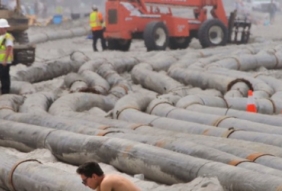
Posted on June 9, 2016
By Edward Sifuentes, The San Diego Union-Tribune
The annual dredging of the Oceanside harbor was set to get under way this weekend, about two months later than usual — a delay that some say has led to dangerous conditions.
Each year around April, the Army Corps of Engineers removes about 180,000 cubic yards of sand from the mouth of the harbor, where ocean currents have deposited it and formed a sandbar.
Without dredging, the sandbar grows making it difficult for boats to enter. Last week, local boaters were getting nervous about the depth of the water at the harbor’s entrance.
“It’s definitely not a good situation right now,” said Capt. Joe Cacciola, who provides sports-fishing tours and burial services at sea aboard his boat, the Sea Star.
Greg Fuderer, a senior public affairs specialist with the Army Corps of Engineers, said Friday that the dredging was delayed this year because there is a new contractor handling the work.
The good news is that more sand than usual will be removed — about 260,000 cubic yards — because the city wants to better replenish its beaches, Fuderer said. Sand that’s pulled from the harbor is typically deposited just north of the pier, and helps create wider beaches that are more attractive to visitors.
The one-year contract for this year’s work will cost about $5 million, and can be extended for an optional two years for a cost of $11.5 million.
Dredging was set to begin Saturday and will probably run through July.
Sand naturally accumulates around jetties during the winter months and can cause the harbor to become shallower. This year’s El Niño event created some elevated surf that increased the movement and accumulation of sand, said Ryan Keim, a spokesman for the Oceanside Police Department.
Keim said the additional sand was minor and did not create any unusual conditions. But until the excess sand is removed, boaters should be aware.
“Police would like to remind boaters to monitor swell and tidal conditions before operating a vessel,” Keim said. “Conditions change rapidly and it is crucial boaters remain alert and informed.”
Experienced boaters know what to expect but the situation can be dangerous for inexperienced people and those who are new to the harbor, Cacciola said.
When the harbor is properly dredged, water can be 22 feet deep but at low tide, when sand hasn’t been removed, the bottom can be just 9 feet down, he said.
The sandbar can also kick up waves up to 12 feet tall, Cacciola said.
“When the swells come in, they hit the sandbar and they stand up and that’s when the danger comes in,” the captain said.
In May, an outrigger canoe was caught in 12-foot surf at the mouth of the harbor and flipped. Six people on the vessel were tossed into the water and had to be rescued by police and lifeguards.
Cacciola said he’s had to cancel four outings this spring on his 60-foot boat because he felt it could not safely navigate the water conditions. He said he hopes the contractor hired by the Corps is able to do the job quickly as the busy summer season approaches.
Source: The San Diego Union-Tribune





